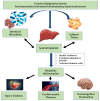Mechanisms of Non-Alcoholic Fatty Liver Disease in the Metabolic Syndrome. A Narrative Review
- PMID: 33578702
- PMCID: PMC7916383
- DOI: 10.3390/antiox10020270
Mechanisms of Non-Alcoholic Fatty Liver Disease in the Metabolic Syndrome. A Narrative Review
Abstract
Non-alcoholic fatty liver disease (NAFLD) and metabolic syndrome (MS) are two different entities sharing common clinical and physio-pathological features, with insulin resistance (IR) as the most relevant. Large evidence leads to consider it as a risk factor for cardiovascular disease, regardless of age, sex, smoking habit, cholesterolemia, and other elements of MS. Therapeutic strategies remain still unclear, but lifestyle modifications (diet, physical exercise, and weight loss) determine an improvement in IR, MS, and both clinical and histologic liver picture. NAFLD and IR are bidirectionally correlated and, consequently, the development of pre-diabetes and diabetes is the most direct consequence at the extrahepatic level. In turn, type 2 diabetes is a well-known risk factor for multiorgan damage, including an involvement of cardiovascular system, kidney and peripheral nervous system. The increased MS incidence worldwide, above all due to changes in diet and lifestyle, is associated with an equally significant increase in NAFLD, with a subsequent rise in both morbidity and mortality due to both metabolic, hepatic and cardiovascular diseases. Therefore, the slowdown in the increase of the "bad company" constituted by MS and NAFLD, with all the consequent direct and indirect costs, represents one of the main challenges for the National Health Systems.
Keywords: MAFLD; NAFLD; epigenetics; insulin resistance; metabolic syndrome; oxidative stress.
Conflict of interest statement
The authors declare no conflict of interest.
Figures


References
Publication types
LinkOut - more resources
Full Text Sources
Other Literature Sources
Research Materials

